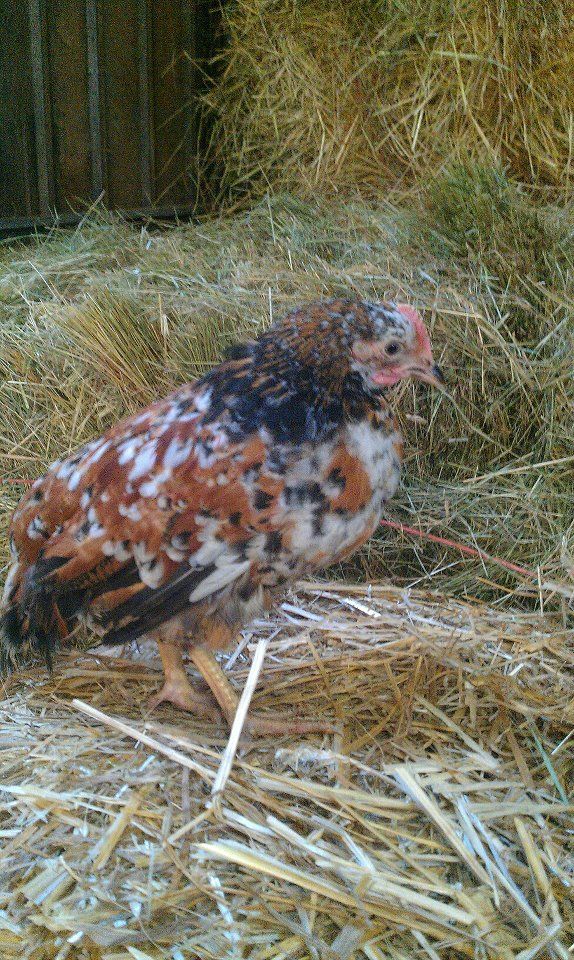Answering the main question on color - Depends on your environment.
But if you free range/pasture your birds in a place with a decent balance of shrubs, grass, dirt, twigs, possible trees, these are some colors that do well:
wildtype BBR / gold duckwing
partridge
crele (or any mostly gold-based tri-colored barred bird)
tolbunt
mille fleur
melanized wheaten (darker version of wheaten often found in Asils, Cubalayas, Shamos)
gold laced
The color on speckled sussex actually doesn't do as well as the similar mille fleur or tolbunt because the mahogany gene makes the dark red just too dark, and the bird more like a mottled in the distance, which doesn't blend in as well with lighter brown shades such as with dirt, dead grass, twigs, etc. Best to aim for colors that are "complicated" and busy but with a good amount of medium and/or light browns as well as a little black here and there. Light mottling like found on a good Mille Fleur or a rare/good Tolbunt also help when encountering environments with flowers, wintery climate, dead woody twigs/shrubs/stumps, and even glossy foliage.
If you're in a more wooded area or a poorly cleaned clearcut, colors like silver laced, silver penciled, barred, and mottled also work well.
If you're in a densely wooded/forest area, melanized duckwing (also known as brassyback) does very well as well as the more melanized (dark) Easter Egger colors. Colors that have plenty black and dark brown markings with little hints of normal brown and possibly gold.
I have a big mix throughout my yard of different environments and find some interesting matches of what color bird goes best with what area. To my surprised some more flashy colors you wouldn't imagine doing well as camo actually do very well in certain areas. For example the silver laced - Very good if you're in a rainy or cloudy climate with lots of woody objects. After a while, the wood gets worn down to a glimmery silvery gray and white color, and with twigs here and there in clearcuts, there's a good "black and white" theme going on in which most black and white wildly patterned birds do well. Throw in a little brown and they're even better.
The worst camo through my experience seeing in any environment my place holds is honestly straight-up pure black.
But if you free range/pasture your birds in a place with a decent balance of shrubs, grass, dirt, twigs, possible trees, these are some colors that do well:
wildtype BBR / gold duckwing
partridge
crele (or any mostly gold-based tri-colored barred bird)
tolbunt
mille fleur
melanized wheaten (darker version of wheaten often found in Asils, Cubalayas, Shamos)
gold laced
The color on speckled sussex actually doesn't do as well as the similar mille fleur or tolbunt because the mahogany gene makes the dark red just too dark, and the bird more like a mottled in the distance, which doesn't blend in as well with lighter brown shades such as with dirt, dead grass, twigs, etc. Best to aim for colors that are "complicated" and busy but with a good amount of medium and/or light browns as well as a little black here and there. Light mottling like found on a good Mille Fleur or a rare/good Tolbunt also help when encountering environments with flowers, wintery climate, dead woody twigs/shrubs/stumps, and even glossy foliage.
If you're in a more wooded area or a poorly cleaned clearcut, colors like silver laced, silver penciled, barred, and mottled also work well.
If you're in a densely wooded/forest area, melanized duckwing (also known as brassyback) does very well as well as the more melanized (dark) Easter Egger colors. Colors that have plenty black and dark brown markings with little hints of normal brown and possibly gold.
I have a big mix throughout my yard of different environments and find some interesting matches of what color bird goes best with what area. To my surprised some more flashy colors you wouldn't imagine doing well as camo actually do very well in certain areas. For example the silver laced - Very good if you're in a rainy or cloudy climate with lots of woody objects. After a while, the wood gets worn down to a glimmery silvery gray and white color, and with twigs here and there in clearcuts, there's a good "black and white" theme going on in which most black and white wildly patterned birds do well. Throw in a little brown and they're even better.
The worst camo through my experience seeing in any environment my place holds is honestly straight-up pure black.
Last edited:







